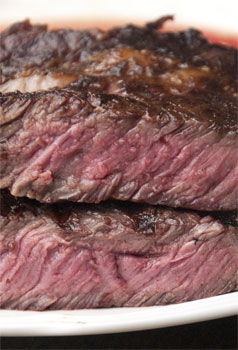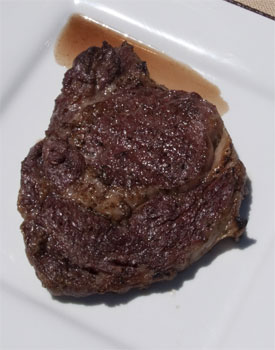
 Ribeyes.
Ribeyes.
Just typing the word makes my keyboard cower in fear of drool. Ribeyes are, in my humble opinion, the best steaks on the steer. And I am not alone. Chef Jamie Purviance agrees. Jamie is the well known author of several cookbooks, most recently the New York Times bestseller, Weber's Way to Grill: The Step-by-Step Guide to Expert Grilling. Jamie graduated from Stanford University and the Culinary Institute of America (with high honors), and his byline appears regularly in Bon Appetit, Better Homes and Gardens, Cooking Light, Eating Well, Fine Cooking, Town & Country, and the Los Angeles Times. He da Man.
Da Man was in my kinda town, Chicago that is, a town that loves its steaks, and we got together on a rooftop with a huge rib roast and two identical Weber Kettle charcoal grills to answer the kind of question that keeps steak lovers like us up all night: When is the best time to sear a steak, when you start cooking, or at the end of the cook? Here's the theory:
Most beef lovers will agree that a dark brown exterior on a thick grilled steak carries with it extraordinary flavor and texture, and that steaks are their most tender and juicy when cooked rare to medium rare, to about 125 to 135F in the center.

Searing, it has been proven, does not seal in juices, contrary to popular opinion. Juices can still escape by puncture or by evaporation. Searing does not weld muscle fibres shut. Searing is a method of developing spectacular flavor and texture when the Maillard reaction starts to alter amino acids on the surface and caramelization of sugars joins the party. Lots of grillers thrill when they get dark cross-hatched grill marks, but to steakmasters, grill marks leave a lot of real estate on the surface unseared, lacking flavor. To steakmasters, the perfect sear is a uniform whiskey brown surface with perhaps a little black charing of the fat on the edges. When that occurs, you have so changed the composition of the muscle and fat, that you have reached steak Valhalla.
The usual method is to get a grill rip-snorting hot on one side, and cooler on the other, the classic 2-zone setup. Then get that sear on the hot side and slide the steak to the cooler part of the grill so the interior can come up to temp without the exterior burning. Jamie calls this method Sear & Slide.
 Food scientists have recently touted a new method that I call Sear in the Rear (some folks call it Reverse Sear). Here's how it works: Take the meat out of the fridge about an hour before cooking time. Start cooking the meat on the cooler side of the grill, at 225 to 275F, bring the meat's internal temp up to 115 to 120F, and then move it over the direct scorching heat to sear. The theory is that there are enzymes in the meat called cathepsins that break down the connective tissues and, if given a chance to work, the meat will be more tender. These are the same enzymes that go to work during dry aging, another tenderizing scheme. They work slowly at refrigerator temps, and shut down at about 122F. But they work well at room temp and up to 122F. By bringing solid muscle meats out of the fridge to sit at room temp, we give them a chance to get to work tenderizing the meat. The process can be speeded along by cooking steaks at a low temp, at first, say 225F, rather than at high heat.
Food scientists have recently touted a new method that I call Sear in the Rear (some folks call it Reverse Sear). Here's how it works: Take the meat out of the fridge about an hour before cooking time. Start cooking the meat on the cooler side of the grill, at 225 to 275F, bring the meat's internal temp up to 115 to 120F, and then move it over the direct scorching heat to sear. The theory is that there are enzymes in the meat called cathepsins that break down the connective tissues and, if given a chance to work, the meat will be more tender. These are the same enzymes that go to work during dry aging, another tenderizing scheme. They work slowly at refrigerator temps, and shut down at about 122F. But they work well at room temp and up to 122F. By bringing solid muscle meats out of the fridge to sit at room temp, we give them a chance to get to work tenderizing the meat. The process can be speeded along by cooking steaks at a low temp, at first, say 225F, rather than at high heat.
Well that's all Jamie and I needed to plan a nice steak lunch! Dueling grills, dueling ribeyes cut from the same roast side-by-side. May the best steak win. Completely unrehearsed, watch the video above and see what happened.
Click here for more on the Secrets of Great Steakhouse Steaks.
Click here for more info about the different cuts of beef.
Click here for a buying guide to beef labels and grades.
Click here for still more articles by Meathead on cooking beef.
Tell us about the most memorable steak you ever had.
--------------------------------
All text and photos are Copyright (c) 2010 By Meathead, and all rights are reserved.
For more of Meathead's writing, photos, and recipes, please visit his website AmazingRibs.com.
Friend him on Facebook.